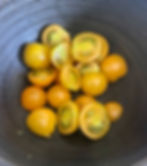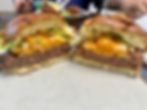Comparing Impossible and Beyond Burgers
- the_maestro
- Jul 13, 2022
- 6 min read
I confess I was a shameless ridiculer of the new meat-substitute products that have flooded the market and taken even fast food restaurants by storm in the last several years. Perhaps this is because I have never found a meat alternative that even approaches resembling the real thing. Perhaps it is my view that veggies should be delicious in their own right and don't need to be made to taste like anything else. Or, perhaps it is because I myself am not a believer in the idea that meat consumption is intrinsically unethical, so I've had no reason to try these products.
A friend and one of the two regular readers of this blog recently asked if I'd tried the meat-alternative products that have blown up of late, and brought another argument for their inclusion in American diets to my attention––these meat alternatives are far less environmentally taxing, with some estimates pinning them as responsible, pound-for-pound, for 90% fewer emissions and a similar percentage less water use. Even for someone with no initial objections to the consumption of animal flesh, the sustainability argument, given the values I cherish, can't be ignored.

We had two "Hawaiian"-style hamburger buns left after making beef burgers a few days prior, and I was happy to find both Impossible brand and Beyond brand ground "beef" at my mom's local Iowa supermarket.
To accompany, I kept things traditional––tomato, lettuce, onion, and a condiment––but elevated in true Maestro style. We had some fragrant, cherry-sized sunsugar yellow-orange tomatoes just becoming ripe in the garden, which I plucked from the vine and cut in half, and also sliced up a sweet Walla Walla onion from the garden. The deer have decimated our cache of Bibb lettuce, so I grabbed a head of local "living" Boston Bibb from the store, as well as some wonderful 10 year-old Wisconsin cheddar. For the condiment, I combined some gochujang (Korean fermented chili paste) with mayo to give the burger a little heat and complexity.

Off to the races!
Thrillist gives a good comprehensive head-to-head comparison of the ingredients in each product:
Impossible meat patties are made from a blend of soy and potato protein, mixed with sunflower oil, yeast extract, salt, and a whole lot of other scientific-sounding ingredients... The most notable thing about Impossible patties is the inclusion of heme, an iron ion found in all living things that gives meat its inherently meaty flavor. The heme used in Impossible Foods is derived from fermented soybeans.
Like Impossible, Beyond Meat’s patty is also made from a blend of plant proteins—just different plants. Beyond contains a mixture of pea, mung bean, and rice proteins, canola and coconut oil instead of sunflower, potato starch, and beet juice extract to give the “meat” its pink hue.
For the patties, I formed them the same way I would a beef burger––took the same amount of "meat" out of each package and mixed it with sea salt and cracked black pepper, then dusted the formed patties with salt and pepper on each side. The differences were immediately apparent––the Impossible burger was significantly less moist, but not unpleasantly so, and held together nicely while forming the patty. Beyond was much softer and stickier, and harder to consolidate into a patty, with a distinct aroma as well, one that vaguely reminded me of cat food. The color was also different, with the Impossible burger displaying a pinker hue compared to the more drab Beyond look––though this would change as they cooked!
In the two pictures below, Impossible is on the left and Beyond on the right.


When grilling, the Impossible burger got a much better Maillard reaction, with some lovely browning, crisping, and "grill lines" on the exterior. The Beyond burger didn't respond as similarly to beef to the heat of the grill, perhaps because there seemed to be more moisture in the Beyond burger. I cooked them both at the same location on the grill for the same amount of time for a direct comparison, adding some cheese at the end (the drier, aged cheddar didn't cut cleanly into "sheets" the way I wanted it to!).

I dressed the burgers over buns toasted on the grill, with the cheesy patty on bottom, topped by onions and tomatoes, a dollop of gochujang mayo, and a leaf of Bibb lettuce. I cut each burger in half and gave half of each to mom, the "Vicetro".

The Beyond burger displayed a uniform, pinkish-brown color throughout the patty, and had the same vague aroma that I experienced when forming the patty. The Impossible burger, meanwhile, looked a lot more like a medium beef burger, with a greyer exterior and decidedly pink interior.

In terms of flavor, the Beyond burger was much more distinct from beef––it did not much resemble beef, but still had some nice umami as well as a marked sweetness. The texture was a bit less toothsome than the Impossible burger and instead a bit spongier. The Impossible burger, meanwhile, could have easily been mistaken for beef for much of the duration of the chew, until the end when it took on a hint of an unpleasant chemical-ish afterburn, and also had a drier texture, particularly on the crunchier exterior. I'd heard the Impossible burger created a "juiciness" resembling beef, even to the point of juices flowing from the "meat," but I didn't find this to be the case with either burger, even at a medium-rare-to-medium temperature. That's something I definitely missed relative to beef.


I paired the burgers with a simple Bibb lettuce salad in a honey mustard dressing with more sunsugar tomatoes, as well as Yukon gold fries made in the air fryer. The remaining gochujang mayo was a delightful, piquant dipping sauce for the fries. Minimize your food waste and use everything you can!

Finally, I opened a bottle of Spanish Bobal to pair. Medium-full bodied with bright blue fruit, food-friendly acidity, and some nice tannic grip, it was a delightful pairing with the burger.

So what's the verdict? For folks seeking something that most closely resembles beef, the Impossible product is hard to beat. I'd heard, with a great deal of skepticism, how similar Impossible is to the "real thing," and I gotta admit that I did find the finished product remarkably close, but certainly not exactly the same––it lacked the depth of umami of real beef, but most notably the juiciness. Wild to see non-beef burgers look so close to medium rare beef, though! I might even be bold enough to say that were I not making a direct comparison to beef, the Impossible burger might taste better than a beef burger.

The Beyond burger, meanwhile, has some "beefy" umami to it and tasted very good, but didn't bear much resemblance to the real thing. The texture was fairly nondescript and the interior not much different than the exterior. As mentioned, it had a vague aroma that wasn't unpleasant, per se, but did remind me of cat food in a way, and the patty had a notable sweetness distinctly unlike beef. For those vegetarians or vegans who might be squeamish about consuming something that closely resembles beef, the Beyond burger might be just the ticket.
As a brief postscript, I could make many philosophical arguments adding nuance to the debate about the ethics of eating meat, but instead I'll say this––I enjoyed both of these burgers, and even might have liked the Impossible burger better than a beef burger in some ways, but I am suspicious of the impulse to make non-meat items taste like meat. Vegetables are glorious on their own––why are we racing to make them taste like something they're not? I would be far more compelled to enjoy a portobello mushroom as a "burger" filling, or a wonderful falafel. These beef substitutes may be getting closer to mimicking the real thing, but they do so with increased processing and scientific tinkering, which further removes our food from its natural ecosystems and nutrient potential.
Don't get me wrong––products like this fill an important role, perhaps, for example, for people who are transitioning to meat-free diets for health or ethical reasons, or for meat lovers looking to turn their burger nights into less environmentally-heavy affairs. And both of these products were delicious, albeit in their own distinct ways. I would not necessarily hesitate to add Impossible "beef" in particular to my regular rotation.
But if we collectively want to transition our diets to more plant-based foods, which seems both advisable and inevitable, why not rejoice in the glorious flavors and culinary potential of unadulterated plants, particularly those with little distance from the soil, rather than engaging in increasingly sophisticated attempts at mimickry?